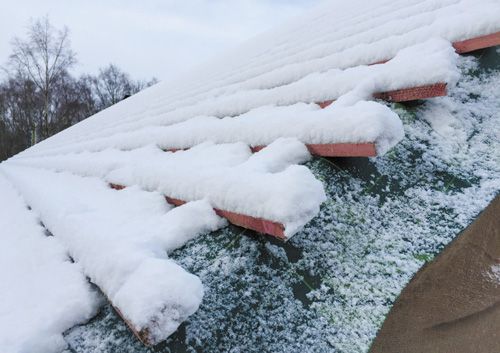 In the winter, strong winds, freezing cold temperatures, snow, ice and lots of rain can create major hazards on building sites. As well as the risk of slips and falls, prolonged exposure to the cold can cause construction workers to suffer from more colds, bronchitis, asthma, painful joints and fatigue. In extreme cases, workers outside for long periods without the right protection could even suffer hypothermia, frostbite and chilblains.
In the winter, strong winds, freezing cold temperatures, snow, ice and lots of rain can create major hazards on building sites. As well as the risk of slips and falls, prolonged exposure to the cold can cause construction workers to suffer from more colds, bronchitis, asthma, painful joints and fatigue. In extreme cases, workers outside for long periods without the right protection could even suffer hypothermia, frostbite and chilblains.
Surprisingly, the risks of cold weather actually start to increase at relatively mild temperatures and it doesn’t have to be snowing before protective measures need to be taken. For example, a 20-mph wind can make a temperature of 10°C feel like zero. This wind chill factor can be worse for those working at height – such as roofers – and they are also at particular risk from high winds. A sudden gust of wind can lead to loss of balance and cause a roll or sheet of roofing underlay to become extremely mobile and very dangerous.
Rain, ice and snow can also make working platforms very slippery. This means it may be unsuitable for roofing work to be carried out in winter, when other trades at ground level could continue. That’s why it is vital that roofing contractors carry out their own thermal risk assessments and follow health and safety procedures.
Working in windy conditions
The National Federation of Roofing Contractors (NFRC) has set out maximum wind speeds for roofing and cladding work and all contractors should follow these guidelines, which state that:
- All laying or handling of slates, tiles, battens and felt at roof level should cease when the (average) mean wind speed reaches 23 mph (gusting to 35 mph or over).
- When handling rolls of felt at roof level, extreme care should be taken when the mean wind speeds are in the region of 17 mph (gusting to 26 mph or over).
For full guidance, including maximum wind speeds for sheeting and decking, download ‘Roofing and Cladding in Windy Conditions’ from www.nfrc.co.uk/knowledge-hub/document-access-form
Working in snow and ice
While the NHBC states that mortar should not be used below 2°C to resist frost damage, there is no such definitive industry regulation for when it is too cold for construction workers.
However, contractors must carry out risk assessments and take appropriate action to protect employees, in accordance with the Health and Safety at Work Act and the Management of Health and Safety at Work Regulations.
The CDM Regulations require that outdoor work is arranged and equipment / clothing is provided to protect workers from adverse weather. In addition, the Work at Height Regulations 2005 specifically state that work should not be carried out if weather conditions could endanger the health and safety of workers. The HSE publication ‘Health and Safety in Roof Work’ also gives advice on controlling the risks of adverse weather conditions.
It is important to follow this safety advice and ensure all employees working on site are prepared for winter conditions, as Gary Walpole, the NFRC’s technical and health & safety officer, told us: “Accident statistics prove that there is an increased risk of personal injury during the winter months, and increased hazards from reduced daylight hours and inclement weather means precautions need to be taken in advance to protect the wellbeing of our workforce.”
So, what precautions should roofing contractors take this winter?
For managers / supervisors …
- Monitor the weather forecast so you can anticipate and be prepared for poor weather conditions.
- Carry out a risk assessment every day to check that it is safe to work and that conditions haven’t changed. Pay particular attention to working at height platforms and do not work on roofs in icy conditions – this is a requirement of the Working at Height Regulations 2005.
- If windy, HSE recommends that roofers should check wind speeds with a hand-held anemometer and refer to the NFRC guidance.
- Make sure workers are trained on winter hazards and ensure they have the appropriate PPE.
- Limit worker exposure to cold through job rotation and provide plenty of breaks in heated areas with hot drinks available.
For roofers …
- Make sure you are wearing the right PPE and extra clothing suitable for the job and the weather conditions. This usually involves using several layers of clothing, as well as waterproofs or wind resistant fabrics where necessary. Also, choose water resistant footwear, with enhanced slip resistance or ice grips if required.
- Wear gloves when fine manual dexterity is not required and the temperature drops below 4°C.
- Cold weather increases the risk of hand-arm vibration syndrome, so keep your hands and arms warm when using vibratory equipment such as drills, nails guns and even hand tools, such as hammers.
- Choose hats that work with safety headgear and don’t compromise on any eye or hearing protection.
- Be aware of the symptoms of cold exposure – heavy shivering, uncomfortable coldness, numbness, aching, severe fatigue, confusion, drowsiness and / or euphoria.
- With reduced daylight hours, visibility can be a problem, so wear reflective PPE.
- Take breaks in heated areas and drink plenty of fluids, including water and warm beverages.
- Report any hazardous areas to the site manager and do not put yourself at risk just to complete a job.



